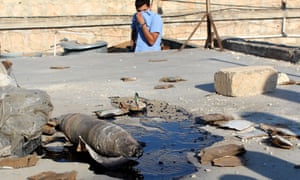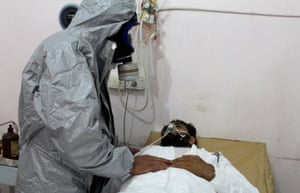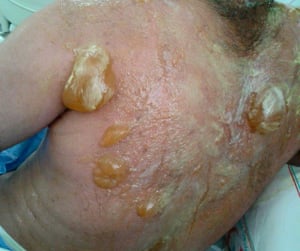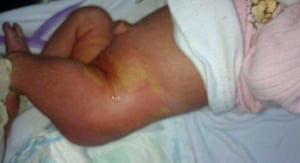'My body was burning': survivors recall horror of Isis mustard gas attack
the guardian21 August attack in Syria is believed to be second time militants have used banned substance and is seen as escalation in civil war
Warning: this article contains graphic images of injuries caused by mustard gas
When the artillery shells whistled overhead, Ahmed Latouf hid in his kitchen with his wife and children and waited for their impact. They thudded into the fields nearby, causing no damage – or so Latouf thought.
Twelve hours later, however, his skin started to bubble and weep. His wife was soon in worse shape, with giant blisters spreading across her shoulders and most of her body gripped by a burning rash. His four-day-old daughter was in an even worse condition, and is not expected to live.
The 21 August attack left as many as 25 people in the northern Syrian village of Marea contaminated by a substance that has since been confirmed as mustard gas, a chemical weapon banned under the 1925 Geneva protocol.
The gas was loaded into artillery shells and fired from about 8km away, from an area controlled by Islamic State. The attack marked the second time that Isis is believed to have used the outlawed substance and is being seen in the opposition-held north and in Turkey as a serious escalation in the civil war.
In late August Kurdish troops in neighbouring Iraq were also affected by mustard gas, a substance first used in the first world war, and sporadically in wars across the world in the century since.
Isis is thought to have fired 59 shells on Marea, a small village near the Turkish border town of Killis that stands between their current frontline and apparent goal of Azaa, a large border post 10 miles further west. The extremists have twice tried to storm Marea and been pushed back by rebel groups who chased them from the area 18 months ago.
The rebels have resisted Isis attempts to return, bringing with them an increasing amount of heavy weapons, some looted from Iraq, others from Syrian bases, and yet more bought on a buoyant black market across the chaotic north.
Latouf, 31, his family and three more of the wounded from Marea were taken across the Turkish border into Gaziantep, where they are now being treated in hospitals.
“It happened at sunset,” he said from his hospital bed. “It smelt like garlic. At sunrise, my body was burning. I went to hospital and they took me straight to Turkey. My body was swollen, I had water bubbles all over it. Now it looks like I have second degree burns. I hope I can return to a normal life.
“The real problem is my daughter, she was four days old when the attack happened. She’s still in critical care. My wife is not as critical as our child.”
On the other side of Gaziantep, which has been a hub throughout the war for Syria’s war wounded and refugees who have escaped the fighting, a former general in the Syrian army’s chemical weapons division said he had received biological samples from the attack in Marea, which had been proven to be mustard gas.
“They were brought across the border and they have been checked,” said Zaher Saket, who fled his position in early 2012 after being ordered to use chemical weapons against demonstrators.
Since sarin was removed in 2013 following a UN resolution that aimed to avoid a US-led attack on the Syrian regime, there have been 126 cases of gas being used in Syria, and 125 of them were chlorine used by the regime, Saket claims.
“This is the first time that [mustard] gas has been used [in Syria]. It was artillery. I got a call from a [rebel] leader who sent me photos and asked me what the shells and substance they used were.
“I thought it was chlorine at the beginning, but after 12 hours, I got new photos from wounded children, and I understood then that it was mustard gas.
“When it comes close to food, clothes, or water it has no symptoms for 12 to 16 hours.
“I assume they [got it] from the regime, or Tehran, or [seized it] from the Iraqi military storage sites [that were raided by Isis last year].”
Jerry Smith, the former head of operations of the Organisation for the Prevention of Chemical Weapons/UN mission to Syria, said: “The photographs of the injuries and the unexploded projectile, along with the outline description of the events, are consistent with the characteristics and damaging properties of mustard chemical warfare agent.”
On Saturday, eight days after the attack, Turkey announced that it had sent its fighter jets to attack Isis sites in Syria. Turkish media, citing defence officials, said the attacks were the fourth against Isis in the month since Ankara launched a war against the Kurdish separatist group, the PKK, whose ally the YPG has been fighting ground battles against Isis in northern Syria.
Turkish jets are reported to have carried out more than 300 strikes against Kurdish targets in the same period.
The fighting, which has been supported by US fighter jets, has pushed the terror group back from the Turkish border. Kurdish militias are now in control of a stretch of the Turkish border from the Iraqi frontier until just east of Marea. And, in north-western Syria, they also control the border north of Idlib.
Isis is battling Syrian rebel units, among them jihadi groups, for control of the area between the Kurds. If they were to seize the border post, they would control a vital supply line into northern Syria.
US jets have been positioned since July in the Incirlik base, 30 minutes flying time from northern Syria, and have since launched an estimated 12 attacks against Isis targets around the Marea area.
Ankara’s invitation for the US to send jets to Incirlik came after more than a year of refusing requests from Washington. However, it has done little to convince US officials that both allies see the war through the same interests.
“The Kurds are our only real ally on the ground, and Turkey keeps attacking them,” said one senior western official. “We’re not yet able to reconcile that with our definition and the rest of the world’s definition of who the enemy is.”
Additional reporting by Saalim Rizk




No comments:
Post a Comment